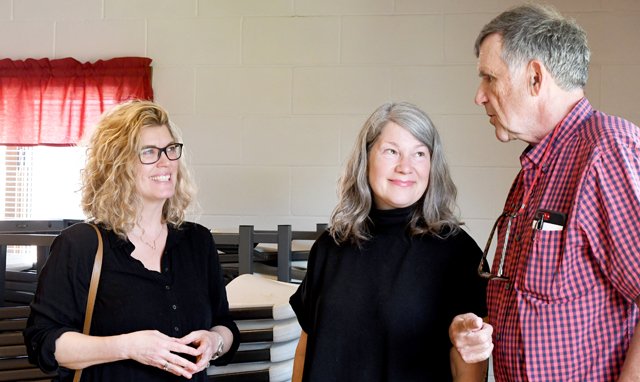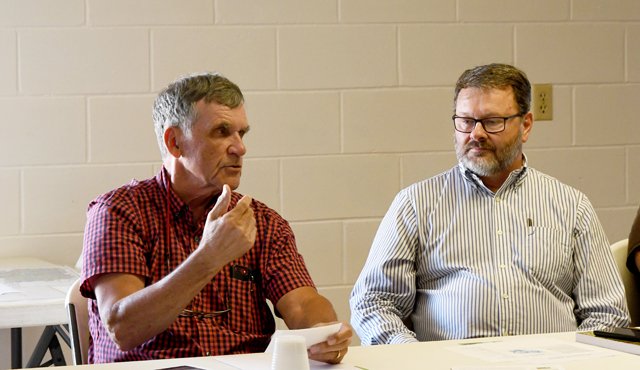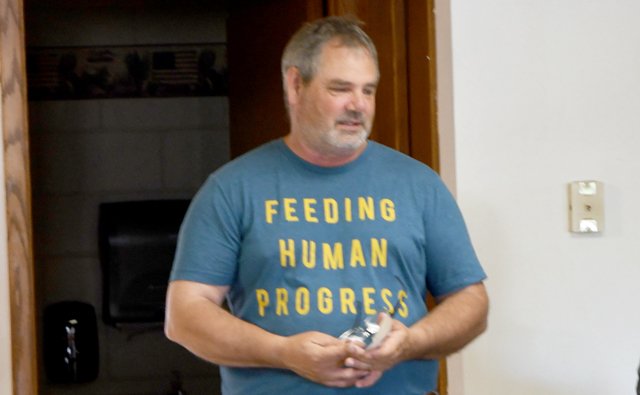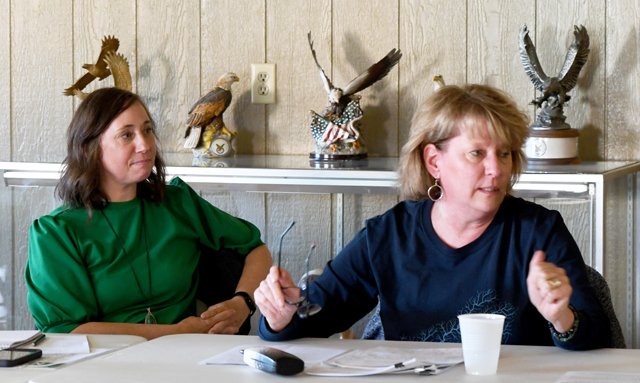VIROQUA - About 40 members of the Tainter Creek, Bad Axe River and Coon Creek watershed councils gathered for a joint meeting at the Eagles Club in Viroqua on Thursday, June 9. After the meeting, the group was treated to a delicious burger bar, prepared by Julie Ruef.
All three groups were funded in 2022 through the DATCP Producer Led Watershed Council grant program. The meeting was called to facilitate cross-fertilization of ideas between watersheds, and to see where some synergies in event planning might be possible.


In addition to watershed council members, Vernon County Administrator Cari Redington, State Representative Loren Oldenburg, and Tim Hundt from Congressman Ron Kind’s office were present.
Dr. Monique Hassman, who works with Valley Stewardship Network and the Vernon County Land Conservation Department, began the meeting with a welcome and introductory comments.
“Thanks for taking time out of your busy days to attend this meeting – you are all watershed leaders,” Dr. Hassman said. “This meeting is intended to allow all the watershed councils to learn about the work of the other councils, and the work is all connected by virtue of the fact that all of our waters are part of the Upper Mississippi River Watershed.”
Dr. Hassman said that with the increasing frequency of extreme weather events, the work of the watershed councils are more important than ever. She said that the situation presents both an opportunity and a responsibility.

Tainter Creek
Tainter Creek Watershed Council member Chuck Bolstad provided introductory comments about that watershed council.
“Our watershed council got started when Berent Froiland’s dad and five other farmers from the watershed got together at the Franklin Town Hall to discuss the flooding, and what farmers could do about it,” Bolstad said. “Caring for the environment and nurturing the land for future generations is something that we can all agree is important, and for this reason, it is not a political issue. We have to focus on what we have in common.”
Bolstad said the group adopted a mission which is to keep the waters of Tainter Creek as clean as possible, and their work has attracted partners such as the Vernon County Land Conservation Department, Valley Stewardship Network, the Wallace Center Pasture Project, Grasslands 2.0, Trout Unlimited, and more.

Bad Axe River
Brad Robson took the lead in introducing the Bad Axe River Watershed Council.
“Our watershed council got started at the celebration for Kevin and Carolyn Parr as State Conservation Farmers of the Year,” Robson said. “One of our first actions was to conduct a survey of our members about what their interests were, and the topic of grade stabilization structures, ditch and ravine repairs, and demonstration projects bubbled to the top of the list.”
Robson said that the group’s meetings have been moved around to different member’s farms, and he joked that “unlike the other watershed councils, our members are all in Vernon County.”
He said they have also held meetings recently at Vernon Vineyards, where the owner John Pedretti recently restored a grade stabilization/farm pond structure on his land. He said an upcoming event is planned at the farm of watershed council member Travis Klinkner on the topic of an organic, no-till soybean plot.

Coon Creek Community
Nancy Wedwick, president of the Coon Creek Community Watershed Council, provided an introduction to the group, explaining how the watershed council got its start, and what they have done since.
“Our watershed council got its start in 2021 because Coon Creek has been experiencing too much flooding in recent years,” Wedwick said. “Our group came together, asking what we could do to help ourselves.”
To answer that question, Wedwick said the group decided to “look to our roots.” Those roots include being the location of the nation’s first watershed demonstration project. Wedwick said the group had literally held their first meeting in the Coon Valley Park, just below where the Civilian Conservation Corps (CCC) Camp was located, and whose members were instrumental in the work on the demonstration project.
“This history was one of the reasons our group decided to include ‘community’ in our name, so that our name would include three ‘C’s,” Wedwick said. “We knew that if we were going to make the changes, we needed to see for things to improve it was going to take the entire community.”
Wedwick said that the group had incorporated as a 501C3 non-profit the prior month, and is pursuing federal not-for-profit status as well. They have also been engaged in strategic planning, and have formed partnerships with the Coon Creek Conservation Club, Coon Valley Business Association, and Norskedalen Nature & Heritage Center, as well as with the LaCrosse, Monroe and Vernon County Land Conservation Departments, and Valley Stewardship Network.
Wedwick said the group has also started a Facebook page, and are actively seeking ways to involve youth in the watershed.
Small groups
After the introductions, the group broke into five small groups where members of each watershed council could share information and ideas about what is happening in their group on a variety of topics.
Those topics included cover crops, demonstrations, events, finance, and promotions and outreach.
Events:ideas shared about events that could be sponsored jointly or severally included bringing back Gabe Brown or some other prominent soil health expert, learning more about the recently released Dairy Heifer Grazing Compass tool, grazing of sheep, talking with members of the Turkey River Watershed Council as that group has existed for many years, and working with Trout Unlimited on streambank education events.
Finance:this group was attended by both Cari Redington and Representative Oldenburg. Their group discussed steps to organizing as a non-profit, DATCP funding, and next steps to secure streams of funding: grants, sponsorships, state and county funding.
Promotions/Outreach:the group discussed various social media the councils are using to make information available, and logos and where councils have had those designed.
Demonstrations:discussion in the demonstration group mostly pertained to some pond structures, with Vernon County’s new Conservation Technician Kenny Anderson joining that group, and some of the cover crop/alternative forage projects that Tainter has done.
Cover Crops:one member talked about how he planted this year’s corn green into a winter rye cover that was seeded after last year’s soybean crop. The winter rye was burned down after planting. This led to a great discussion amongst the group. As at other watershed council meetings, farmers enjoy swapping stories about use of cover crops, and likely could have used more time.




